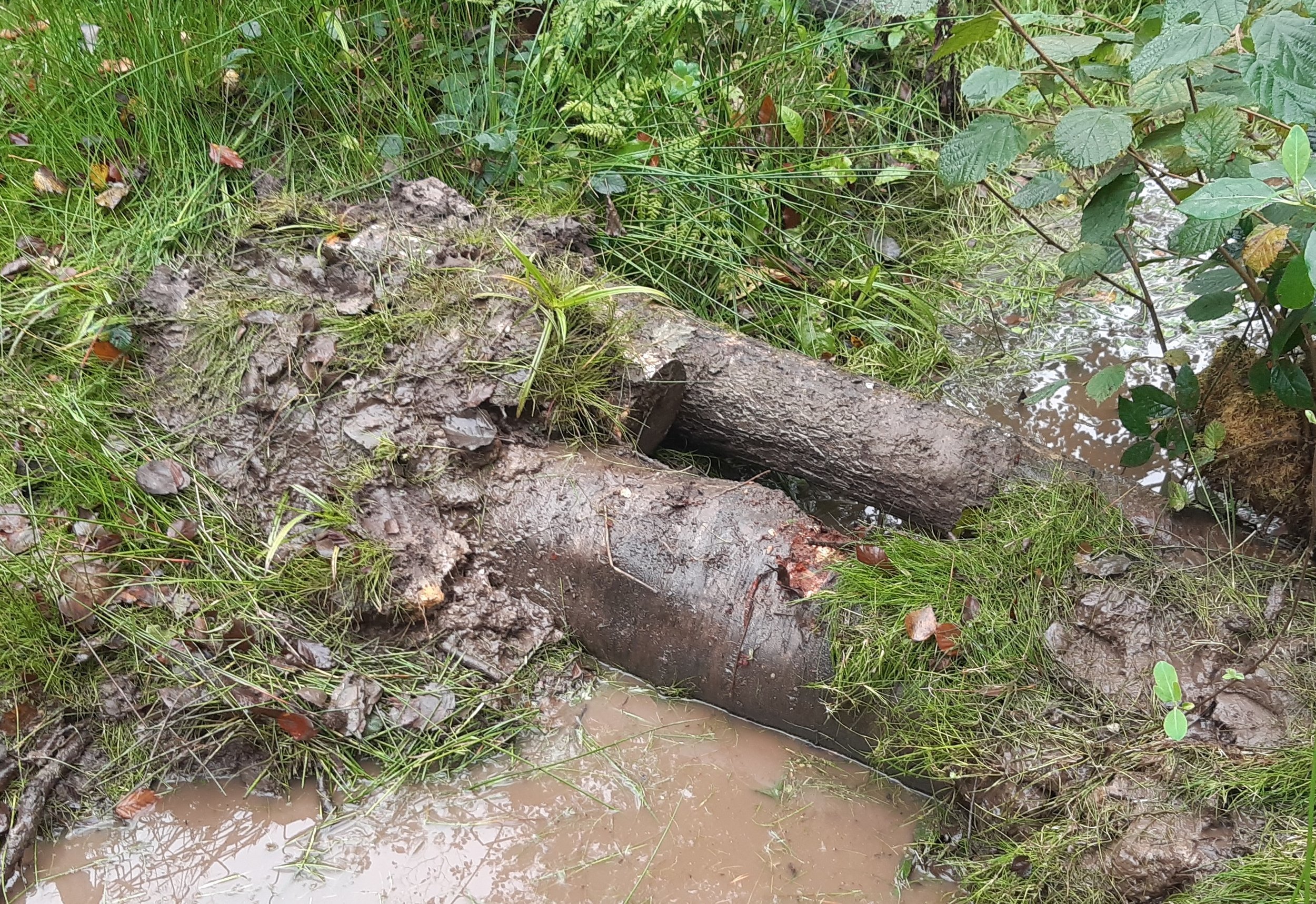Autumn finally shows its face at Wilderness Wood
Monday 23 October 2023
I'm writing this on a Monday since I can't make my regular Tuesday visit this week. On Mondays Wilderness Wood is usually closed to the public and is normally very quiet, but because it is half term they are open and the voices of children and barking dogs are plain to hear.
Concrete base laying for the new workshops at Wilderness Wood
The concrete base to the new workshops are in the process of being poured. Half a dozen men are busy with rakes as a concrete lorry oozes the fluid concrete into the vastness enclosed by Dan’s shuttering. The workshops will have a timber framed roof sitting on top of six half sized shipping containers, which will also provide storage for the tools. The space between the containers will allow for large areas for assembling wooden frames for future building work.
Concrete pouring is too noisy for my liking, so I immediately head for the trees, where I am enfolded in a warm blanket of green solitude. Do trees actually cut down the noise of machinery? Or is it some magical quality of these living giants that brings instant tranquility?
As I'm walking down the cross-ride I am literally spooked by ghostly white figure lurking in the undergrowth. It turns out to be a character on the Halloween themed route through the wood for visiting children.
If its the last week in October there has to be a Halloween theme to Wilderness Wood
Once onto Hemlock Valley things become a little more natural as I observe a couple of developments linked to my conservation work over the last few years.
The first is change brought about by the creation of the first leaky dam built down here, almost exactly 3 years ago. Compare the three photographs below, one taken in 2020, one in 2021 and the other in 2023. The leaky dam has held back both water and silt over the last 3 years to create a perfect environment for the growth of marsh plants.
Three years of Leaky Dam progress at Hemlock Valley - Wilderness Wood
Further down the valley even more spectacular changes have taken place at the site of the new ponds. These were dug in October 2022, filled rainwater over the winter and dried out during the summer of 2023. Recent rain has refilled them. The photos below show the lower pond in 2022 and today (October 2023).
The water levels are not quite high enough, with the now flowing Wilderness Stream taking its natural route via the bypass channel. Insertion of a log into this channel should raise the pond water by 10-12 inches. A will inspect it again next week after further rainfall. I also insert a couple of logs between the lower and middle ponds to see how that partial dam affects the levels. In days-gone-by this sort of 'suck it and see' approach would have been commonplace amongst ordinary Wealden folk, whereas modern day engineers would have it all modelled on computers from the start. I love 'old-school'.
Newly inserted log dam between upper and middle ponds
I drop in on Streamside, where the Wilderness Stream is once again forming a sizeable pond behind the leaky dam there. But I feel that's enough of engineering and decide to do a bit of botanising through the woods.
October is the prime month for fungi and it is not long before I come across one from the Rupert Bear books of my youth – the Fly Agaric. This is not a mushroom for human consumption, unless you are a viking. I'm told some of these, known as Berserkers, used to consume this fungus before battle and would have been off their heads with it. However, this is unlikely since Fly Agaric causes drowsiness, muscle spasms and vomiting - rendering them ill suited to combat. Consuming Henbane is considered much more likely. Death from eating Fly Agaric is rare but not unheard of.
Fly agaric - not to be consumed by humans!
The next fungus is a much safer encounter. This is one of the mostly edible boletus family, although you would be wise to learn a bit more about them before indulging. One of the family, Boletus satanas, is certainly not for eating. In the photo below the boletuses are on the left of the shot and can be seen to have pores on their undersides, whilst the purplish fungus off to the right, probably Russula atropurpurea, has mushroom-like gills on its underside.
Boletus (left) and Russula (right)
Nearby I find what I assume to be Panther Cap (Amanita pantherina). This is distinguishable by the large white warts on its cap and is responsible for many deaths in Europe. The warts are the remains of a universal veil which would have surrounded the button shaped young 'mushroom' before it magically erupted from the ground.
Panther Cap - a poisonous toadstool (when eaten), but fascinating to learn about
Needless to say it is not wise to eat wild toadstools until you can confidently identify those that are edible. However, the next find is not a fungus but the fruit of a tree, the sweet chestnut. These I am confident about identification, although care should be taken when breaking open their spiky fruit cases! When I taught Forest School children, doing my Hedgehog Trail I used to joke that they were the eggs of hedgehogs. I wouldn't fancy laying one though!
Not a native to the UK, they were introduced many centuries ago from southern Europe where the chestnut fruits grow much bigger. Nonetheless you can get a good hot snack out of the bigger ones inside a fruit case.
Sweet Chestnuts - nice roasted on a winter stove, but avoid any found on the woodland floor with holes in them (unless you wanted extra protein!)
My final stop is at Bat Park to inspect the progress of the grassland and the heathland areas. The former is looking healthy, with one or two late flowers still risking blooming during this unseasonally mild weather.
Centaury - October flowering suggests something odd with our climate
A number of cotyledons (flower seedlings) indicate that 2024 may well see a colourful year at Bat Park, which shows all the signs of improving health.
Cotyledon collection at Bat Park - difficult to identify, I think they are as follows (clockwise from top left) - Oxeye Daisy, Ragwort, Ribwort Plantain (pointy) and Sheep Sorrel (red), Selfheal.
I also discover a small hole in the thin soil, surrounded by what looks like screwed-up bits of paper and suspect a species of solitary wasp may have laid eggs in the ground here.
Solitary wasp hole at Bat Park?
The heathland too is looking impressive five years on from the planting of the 1 inch diameter plugs. Planted in rows some 12 inches apart they now run into each other, as big as dinner plates.
Five years on from planting as 1 inch wide plugs, these heather plants are growing quickly and spreading seed across the Bat Park heathland area.
I decide to thin down the birch saplings which are busy sprouting anywhere that their seeds might fall – which is almost everywhere! 15% tree cover is recommended for the most wildlife friendly heathland, enough for birds to perch in, but not so many that they shade the heather plants and slowly turn it back into woodland.
On returning to the central hub area I discover that the concrete layers have done their job with the new workshop base, although Dan is a little miffed that they also partially filled in his drains. Fortunately the concrete is still wet and he sets-to scraping it out. Rain is expected in an hour, so hopefully it will be set solid by then and no roaming doggy paw prints will have been left as a permanent reminder that Wilderness Wood is as much for the animals as the humans who visit it.
The completed concrete base to the new workshops
You are invited to follow my walking and cycling exploration of the King Charles III England Coast Path, its new official title. My wife and I have already completed about half of it, with my aim to finish it all over the next few years. visit www.leggingroundbritain.com.
Onward and upward! David Horne














